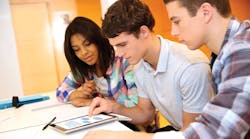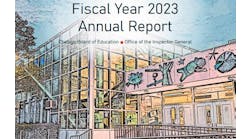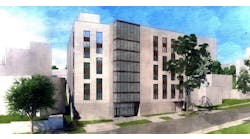It’s a given in schools and universities that technology is a critical element in providing students will a high-quality education relevant to the 21st-century world. Designers and facility managers know that modern classrooms must be able to accommodate technological tools that enhance student learning. That’s easy to state as a concept; it may be difficult to carry out in practice when the pace of technological advances outstrips the ability of administrators to adapt their facilities to keep up with the changes.
Consider: Less than three years ago, the general public had yet to lay eyes on the next big thing Apple was preparing to release. By February of this year, 4.5 million iPads have been sold to U.S.-based education institutions, according to Apple. (Worldwide, the figure is 8 million.) Combine Apple’s tablet computers with other versions produced by competing companies, and the devices are transforming learning for millions of students.
Facility planners can’t necessarily anticipate what technological changes are on the horizon that will send education in a new direction, but they should acknowledge technology’s growing influence in making education more student-centered and individualized and they should create learning environments flexible enough to embrace new technological trends.
“The technology infrastructure of the 19th and 20th centuries is no longer keeping pace with the needs of the 21st-century learner,” says the New Jersey Department of Education’s Facility Guide For Technology. “New, flexible environments that encourage communication, collaboration, production and innovation are required to support student learning of core content knowledge.”
Technology trends
Educators have been saying for decades that technology had the potential to transform education—and it has happened time and again.
Desktop computers in classrooms brought with them a new way for students to gain access to lessons and other education content. Classroom connections to the Internet removed limitations of distance and resources and enabled students to have access to virtually unlimited amounts of information. Laptop computers and wireless technologies made that information available beyond classrooms and school walls.
Not too long ago, seeing a landline telephone in a classroom was less likely than a UFO sighting. Now, nearly every teacher and teenage student has his or her own cell phone in the classroom, and tablet computers, smart phones and other mobile devices have become integral parts of the lives—and learning habits—of many students.
A survey for the Pew Research Center’s Internet & American Life Project of 2,462 Advanced Placement and National Writing Project teachers found that 73 percent of the teachers say they or their students use cell phones in class as a learning device or to complete assignments. Forty-two percent of the teachers said students used cell phones to look up information in class; 38 percent said students used them to take photographs or record video for an assignment; and 18 percent said students used cell phones to upload school-related content to the Internet.
Forty-three percent of teachers say they or their students used tablet computers in class, and 45 percent used e-readers in class.
Flexibility for the future
Those percentages may not be representative of classrooms and teachers in general, but the results show that technologies that barely made a blip on the public consciousness a few years ago can quickly become major factors in student learning. Classrooms should be able to welcome and incorporate these new trends without major disruption.
“Since no one can predict how educational technologies and teaching modalities will evolve, learning spaces must adapt to whatever changes the future may hold,” states a white paper, 21st-Century Learning Environments, produced by the Partnership for 21st-Century Skills.
Classrooms with movable furniture and walls that can be reconfigured for different subjects or class sizes will help students provide the flexibility to adapt to future trends, the white paper says.
New Jersey’s facility guide for technology identifies some of the tools that may be included to create a successful learning environment:
•Teacher workstations with the capacity to display information to an entire classroom.
•Individual networked classroom computing devices.
•Individual, portable computing devices for every child.
•Mobile laptop computer labs on recharging carts with wireless network connectivity.
•Instructional technology and vocational laboratories of 12 to 30 computer workstations.
•Information and technology resource centers with print and digital content and access to online subscription services.
•Distance/virtual e-learning resources for access to global curriculum.
The guide also recommends that instructional areas should have telephones with access to voicemail for each teacher; on-demand access to computing devices; high-speed network access to school, district and global resources; interactive whiteboards; access to digital cameras and discipline-specific peripheral devices such as digital microscopes; and networked black-and-white and color printers with scanning and faxing capacities.
As with most school-design processes, a plan that seeks to involve and get buy-in from a wide range of stakeholders is more likely to meet with success.
Achieving Success
“The design of technology-rich classrooms and schools has to be a collaborative process and the voice of a broad spectrum of stakeholders must be heard in all of the planning and design stages,” the New Jersey guide says. “Teachers, students, technology staff, administrators, support personnel, board of education members and community members will provide valuable input when engaged properly.”
Adapting classrooms and other learning spaces to incorporate new technology is unlikely to succeed unless schools make sure that the teachers and students using those tools have been shown how to use it effectively, according to the 21st-Century Learning Environments paper.
“Putting technology in place is just the starting point; like any tool, its effectiveness depends on the user’s skill in handling it, and on the conditions in which it is employed,” the paper asserts. “Technology can make a difference only when students, teachers, and administrators are provided the necessary supports to effectively integrate it into their daily routines.”
Sidebar: Technology’s Impact
“How Teachers Are Using Technology at Home and in Their Classrooms,” a survey of teachers by the Pew Research Center’s Internet & American Life Project, provides some insight into the ways technology is affecting how students are learning in school:
•95 percent of teachers surveyed say they have student conduct research or look for information online.
•79 percent have students gain access to assignments online.
•76 percent have their students turn in assignments online.
•40 percent of the teachers have students develop, share or post their work online, on a website or blog.
•39 percent have students take part in online discussions.
•54 percent of the teachers say all or almost all of their students have sufficient access to digital tools at school (only 18 percent say all or almost all of their students have access to the digital tools they need at home).
•76 percent of the teachers strongly agree that search engines “have conditioned students to expect to be able to find information quickly and easily.”
•83 percent agree that the amount of information available online today is overwhelming for most students.
• 71 percent agree that digital technologies discourage students from finding and using a wide range of sources for their research.
•Despite the teachers’ heavy use of technology, 42 percent of them say their students usually know more than they do when it comes to using new digital technologies.
Kennedy is staff writer for AS&U.


